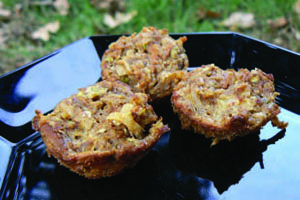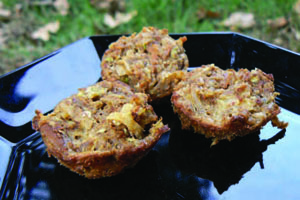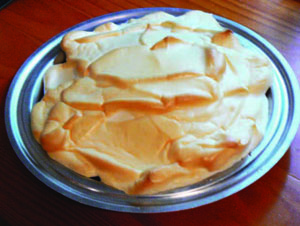Recipes: Issue 46

Desert time! This month, we'll be taking a look at ways to create some Paleo-friendly treats. As I have said before, though, just because the ingredients start out "Paleo", it doesn't mean that everything created from them is necessarily healthy or good for you in large quantities! Remember that deserts were meant to be an occasional treat, not an everyday (or worse, every meal) occurrence. However, if you do have desert, enjoy it! One trick that we like is to eat desert with a small baby spoon or fork. It will slow down your eating and prolong the enjoyment.
If you are newer to Paleo eating, many of these recipes might not seem sweet enough to you. The longer you have been eating Paleo, the sweeter these recipes will seem. You can always adjust the sweeteners, but remember that this is what we are trying to avoid.
There are some gray area ingredients in a few of these. You'll see that I have opted for real Turbinado sugar, real maple syrup, or real honey as sweeteners in these recipes instead of various artificial sweeteners or stevia. Artificial sweeteners still give an insulin response, including stevia. As you'll see, these recipes don't contain many carbohydrates, even with the very light use of real sweeteners.
I'd like to thank my wife Rochelle for doing the work on a lot of these; deserts are not really my specialty (If I want a treat, steak and gluten-free beer works better for me). Enjoy!
Chocolate Almond Milk
Quick and easy. It's tasty for breakfast along with a good hunk of protein!
Even though this one is primarily fat, wouldn't make this a staple in the diet. New research shows that liquid meals cause a greater insulin release than the same meal in solid form.
Time: 5 minutes
• 1 1/2 cup water
• 1/2 cup almonds
• 1 Tbsp carob powder or unsweetened cocoa powder
• 2 tsp either real maple syrup or honey
Soak the almonds in water overnight. Drain the water and rinse the almonds. Transfer the almonds to a blender; add the remaining ingredients. Blend on low until the nuts are well chopped, then increase the speed to liquefy. Blend for 2 minutes, then pour into a glass and serve.
Zone info: 2 servings at .5 carb block, 12.5 fat blocks
Chocolate Pudding
Time: 12 minutes
• 1 can coconut milk
• 1/4 cup tapioca
• 2 squares unsweetened baking chocolate
• 1 Tbsp Turbinado sugar
Combine the tapioca and coconut milk in a small pan. Heat over medium-low, stirring, for 8 minutes. Add the chocolate and sugar, stir until melted. Serve either warm or chilled.
Zone info: 4 servings at 1 carb block, 17 fat blocks
Carrot Cake Muffins
Time: 40 minutes
• 5 egg whites
• 1/2 tsp cream of tartar
• 2 cups shredded carrots
• 1 cup shredded green cabbage
• 1/2 cup unsweetened applesauce
• 1/2 cup coconut oil
• 1/2 cup ground almonds
• 1 cup coconut shreds
• 1/2 cup tapioca flour
• 1/2 tsp baking soda
• 1/2 tsp baking powder
• 1/2 cup chopped pecans
• 1 Tbsp real maple syrup
• 1 tsp cinnamon
• 1 tsp vanilla extract
• 1/2 tsp cloves
Beat the egg whites and cream of tartar in a mixing bowl. You'll need to use an electric mixer, and expect this to take 8-10 minutes. Once they are white and very fluffy, (see meringue recipe) you can finally rest.
In a separate bowl, combine the almond meal, tapioca, coconut shreds, baking soda, and baking powder. Mix well. Add this flour mixture into the egg whites, mixing as you go. Add all of the remaining ingredients and mix thoroughly.
Grease a mini muffin baking sheet with a bit of coconut oil. Add a dollop of the batter to each muffin, then bake at 350 degrees for 20 minutes, or until done. Larger muffins will require a longer baking time.
Zone info: Variable based on the size and number of muffins you make! The recipe totals as written are: 13.4 carb blocks, 2 protein blocks, 135.8 fat blocks. All of you OCD types can divide these totals by the number of muffins you make to get your info per muffin.

Meringue
Time: 45 minutes
• 6 egg whites (save the yolks for another use)
• 1 Tbsp Turbinado sugar
• 1 Tbsp tapioca flour
• 1/8 tsp cream of tartar
• coconut oil
First things first: ALL of your bowls, mixers, etc for this recipe must be completely dry, or your meringue will fail. Also, if you choose to separate the egg whites from the yolks yourself, be very careful not to get any of the yolk into the mixture. If this happens, do 30 burpees and start over. It won't work. I do it the easy way, avoiding burpees and failure by buying the egg whites already separated.
Combine all of the ingredients in a mixing bowl. Beat continuously with an electric mixer until the meringue is light, fluffy, and white in color. This will take a while—around 8 minutes. Don't stop. Once it looks like shaving cream, you've done well.
Lightly grease a baking pan with coconut oil, then pour in the mixture and spread it into a round shape. Bake at 325 degrees for 20-30 minutes, until lightly browned. Allow to cool before serving.
Zone info: 4 servings at 1/2 carb block, 1/2 protein block
Pumpkin Meringue Pie
Time: 1 hour 15 minutes
• 6 egg yolks
• 1 15oz can pumpkin (unsweetened)
• 1 Tbsp real maple syrup
• 1 tbsp real honey
• 1 tsp cinnamon
• 1 tsp ginger
• 1/2 tsp cloves
• 1/2 tsp sea salt
• coconut oil
Separate the yolks carefully from the whites (see meringue recipe). Reserve the whites for use in the meringue. Combine the pumpkin and yolks in a mixing bowl; beat well. Add all of the remaining ingredients, continue to beat until well mixed.
Lightly grease a pie pan with coconut oil. Pour in the pumpkin mixture, bake at 425 degrees for 15 minutes. Reduce heat to 350 and bake for 20 more minutes.
Meanwhile, make the meringue (see recipe in this issue). Once the pumpkin has cooked, top with the meringue mixture. Return to the oven for 20 minutes. Cool and serve.
Zone info: (including meringue) 4 servings at 2 carb blocks, 1.5 protein blocks, 3 fat blocks

If you are newer to Paleo eating, many of these recipes might not seem sweet enough to you. The longer you have been eating Paleo, the sweeter these recipes will seem. You can always adjust the sweeteners, but remember that this is what we are trying to avoid.
There are some gray area ingredients in a few of these. You'll see that I have opted for real Turbinado sugar, real maple syrup, or real honey as sweeteners in these recipes instead of various artificial sweeteners or stevia. Artificial sweeteners still give an insulin response, including stevia. As you'll see, these recipes don't contain many carbohydrates, even with the very light use of real sweeteners.
I'd like to thank my wife Rochelle for doing the work on a lot of these; deserts are not really my specialty (If I want a treat, steak and gluten-free beer works better for me). Enjoy!
Chocolate Almond Milk
Quick and easy. It's tasty for breakfast along with a good hunk of protein!
Even though this one is primarily fat, wouldn't make this a staple in the diet. New research shows that liquid meals cause a greater insulin release than the same meal in solid form.
Time: 5 minutes
• 1 1/2 cup water
• 1/2 cup almonds
• 1 Tbsp carob powder or unsweetened cocoa powder
• 2 tsp either real maple syrup or honey
Soak the almonds in water overnight. Drain the water and rinse the almonds. Transfer the almonds to a blender; add the remaining ingredients. Blend on low until the nuts are well chopped, then increase the speed to liquefy. Blend for 2 minutes, then pour into a glass and serve.
Zone info: 2 servings at .5 carb block, 12.5 fat blocks
Chocolate Pudding
Time: 12 minutes
• 1 can coconut milk
• 1/4 cup tapioca
• 2 squares unsweetened baking chocolate
• 1 Tbsp Turbinado sugar
Combine the tapioca and coconut milk in a small pan. Heat over medium-low, stirring, for 8 minutes. Add the chocolate and sugar, stir until melted. Serve either warm or chilled.
Zone info: 4 servings at 1 carb block, 17 fat blocks
Carrot Cake Muffins
Time: 40 minutes
• 5 egg whites
• 1/2 tsp cream of tartar
• 2 cups shredded carrots
• 1 cup shredded green cabbage
• 1/2 cup unsweetened applesauce
• 1/2 cup coconut oil
• 1/2 cup ground almonds
• 1 cup coconut shreds
• 1/2 cup tapioca flour
• 1/2 tsp baking soda
• 1/2 tsp baking powder
• 1/2 cup chopped pecans
• 1 Tbsp real maple syrup
• 1 tsp cinnamon
• 1 tsp vanilla extract
• 1/2 tsp cloves
Beat the egg whites and cream of tartar in a mixing bowl. You'll need to use an electric mixer, and expect this to take 8-10 minutes. Once they are white and very fluffy, (see meringue recipe) you can finally rest.
In a separate bowl, combine the almond meal, tapioca, coconut shreds, baking soda, and baking powder. Mix well. Add this flour mixture into the egg whites, mixing as you go. Add all of the remaining ingredients and mix thoroughly.
Grease a mini muffin baking sheet with a bit of coconut oil. Add a dollop of the batter to each muffin, then bake at 350 degrees for 20 minutes, or until done. Larger muffins will require a longer baking time.
Zone info: Variable based on the size and number of muffins you make! The recipe totals as written are: 13.4 carb blocks, 2 protein blocks, 135.8 fat blocks. All of you OCD types can divide these totals by the number of muffins you make to get your info per muffin.

Meringue
Time: 45 minutes
• 6 egg whites (save the yolks for another use)
• 1 Tbsp Turbinado sugar
• 1 Tbsp tapioca flour
• 1/8 tsp cream of tartar
• coconut oil
First things first: ALL of your bowls, mixers, etc for this recipe must be completely dry, or your meringue will fail. Also, if you choose to separate the egg whites from the yolks yourself, be very careful not to get any of the yolk into the mixture. If this happens, do 30 burpees and start over. It won't work. I do it the easy way, avoiding burpees and failure by buying the egg whites already separated.
Combine all of the ingredients in a mixing bowl. Beat continuously with an electric mixer until the meringue is light, fluffy, and white in color. This will take a while—around 8 minutes. Don't stop. Once it looks like shaving cream, you've done well.
Lightly grease a baking pan with coconut oil, then pour in the mixture and spread it into a round shape. Bake at 325 degrees for 20-30 minutes, until lightly browned. Allow to cool before serving.
Zone info: 4 servings at 1/2 carb block, 1/2 protein block
Pumpkin Meringue Pie
Time: 1 hour 15 minutes
• 6 egg yolks
• 1 15oz can pumpkin (unsweetened)
• 1 Tbsp real maple syrup
• 1 tbsp real honey
• 1 tsp cinnamon
• 1 tsp ginger
• 1/2 tsp cloves
• 1/2 tsp sea salt
• coconut oil
Separate the yolks carefully from the whites (see meringue recipe). Reserve the whites for use in the meringue. Combine the pumpkin and yolks in a mixing bowl; beat well. Add all of the remaining ingredients, continue to beat until well mixed.
Lightly grease a pie pan with coconut oil. Pour in the pumpkin mixture, bake at 425 degrees for 15 minutes. Reduce heat to 350 and bake for 20 more minutes.
Meanwhile, make the meringue (see recipe in this issue). Once the pumpkin has cooked, top with the meringue mixture. Return to the oven for 20 minutes. Cool and serve.
Zone info: (including meringue) 4 servings at 2 carb blocks, 1.5 protein blocks, 3 fat blocks

|
Scott Hagnas is owner of CrossFit Portland. He is certified as a CrossFit level 2 trainer and Circular Strength Training (clubbell) instructor. He has been riding BMX flatland for 26 years and counting and has filmed/produced/edited several series of BMX videos, plus several training videos. He formerly competed in bicycle trials, placing second in amateur in the World Championships in 1990. Cooking is one of his favorite pastimes. |
Search Articles
Article Categories
Sort by Author
Sort by Issue & Date
Article Categories
Sort by Author
Sort by Issue & Date

